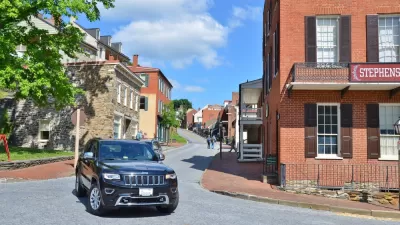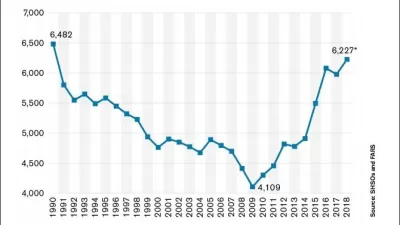Pedestrian deaths are on the rise in the United States, but cities have been slow to implement effective policies and road design measures to change the trend.

While the number of pedestrian deaths has been dropping in other countries, the United States is projected to reach a high not seen in 30 years, reports a team from the Howard Center for Investigative Journalism at Arizona State University.
Drivers are safer than ever in vehicles outfitted with a number of features to better protect them. However, experts do not agree on the causes behind the increase in pedestrian fatalities. They point to distracted driving and an increase in walking, but these factors do not adequately explain the trends seen here in the United States and other countries.
And a closer look at the data indicates that certain places have been disproportionately affected. "The threat posed by vehicles is exacerbated by road designs in many of the country’s most dangerous locations for pedestrians — mostly low-income, predominantly minority neighborhoods in heavily populated Sun Belt cities, such as Los Angeles, Phoenix, Houston and Orlando, Fla."
Arterial roads in these areas are wide with high traffic volumes and speeds. "Many of these roads, which are designed for vehicle speeds of over 40 mph, are hostile to pedestrians. They have sidewalks that abut the travel lanes with minimal separation and lack median islands or sufficient lighting."
Some cities have adopted Vision Zero initiatives to address road safety, but others—such as Phoenix, which has one of the highest pedestrian fatality rates in the country—have fully rejected such strategies. In addition, the European Union has adopted vehicle safety standards to better protect pedestrians, but the National Highway Traffic Safety Administration says such regulations did not pass a required cost-benefit analysis.
FULL STORY: Pedestrians die every 90 minutes in the U.S., and low-income areas are hurt most

Alabama: Trump Terminates Settlements for Black Communities Harmed By Raw Sewage
Trump deemed the landmark civil rights agreement “illegal DEI and environmental justice policy.”

Planetizen Federal Action Tracker
A weekly monitor of how Trump’s orders and actions are impacting planners and planning in America.

Why Should We Subsidize Public Transportation?
Many public transit agencies face financial stress due to rising costs, declining fare revenue, and declining subsidies. Transit advocates must provide a strong business case for increasing public transit funding.

Understanding Road Diets
An explainer from Momentum highlights the advantages of reducing vehicle lanes in favor of more bike, transit, and pedestrian infrastructure.

New California Law Regulates Warehouse Pollution
A new law tightens building and emissions regulations for large distribution warehouses to mitigate air pollution and traffic in surrounding communities.

Phoenix Announces Opening Date for Light Rail Extension
The South Central extension will connect South Phoenix to downtown and other major hubs starting on June 7.
Urban Design for Planners 1: Software Tools
This six-course series explores essential urban design concepts using open source software and equips planners with the tools they need to participate fully in the urban design process.
Planning for Universal Design
Learn the tools for implementing Universal Design in planning regulations.
Caltrans
Smith Gee Studio
Institute for Housing and Urban Development Studies (IHS)
City of Grandview
Harvard GSD Executive Education
Toledo-Lucas County Plan Commissions
Salt Lake City
NYU Wagner Graduate School of Public Service




























